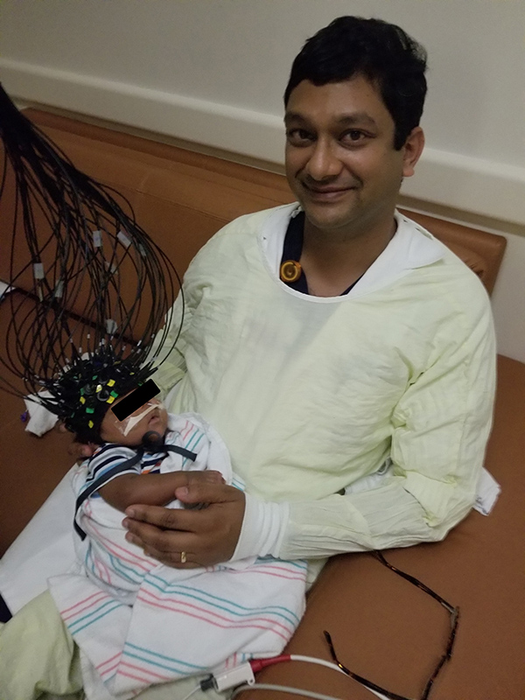A five-year, $2.85 million grant to use novel technology to study babies with hydrocephalus has been awarded to a team of UTHealth Houston researchers by the National Institute of Neurological Disorders and Stroke, part of the National Institutes of Health (NIH).

Credit: Manish N. Shah/UTHealth Houston
A five-year, $2.85 million grant to use novel technology to study babies with hydrocephalus has been awarded to a team of UTHealth Houston researchers by the National Institute of Neurological Disorders and Stroke, part of the National Institutes of Health (NIH).
Co-lead investigators Eva M. Sevick, PhD; Manish N. Shah, MD; and Banghe Zhu, PhD, will deploy a new technique to understand the role that cerebrospinal fluid flow dynamics play in post-hemorrhagic hydrocephalus (PHH) in order to develop prevention, progression, and treatment strategies.
Sevick is a professor and the Nancy and Rich Kinder Distinguished Chair of Cardiovascular Disease Research at the Brown Foundation Institute of Molecular Medicine (IMM) at McGovern Medical School at UTHealth Houston. Shah is an associate professor of pediatric neurosurgery and the William J. Devane Distinguished Professor with McGovern Medical School, and Zhu is an assistant professor with the Center for Molecular Imaging at IMM.
The optical imaging technique – called fluorescence cap-based transcranial optical tomography (fCTOT) – involves the use of a wearable device developed two years ago by Sevick, Shah, and Zhu. The special cap for the baby’s head helps physicians study brain dysfunction with harmless near-infrared light, similar to the light used in a grocery store scanner, without requiring the baby to be put under anesthesia. The technique has been modified for the rapid, whole-brain fluorescent imaging of infants with PHH, allowing researchers to use a safe green medical dye, indocyanine green (ICG), to better track disordered cerebrospinal fluid (CSF) flow in hydrocephalus.
“We hope to translate our basic science, engineering, and laboratory research in whole-brain optical imaging with fCTOT to the bedside to help our smallest patients in the NICU suffering from hydrocephalus,” said Shah, a pediatric neurosurgeon overseeing the care of many patients with hydrocephalus at Children’s Memorial Hermann Hospital. “This grant will fund the first study ever to look at ICG in human CSF circulation and will specifically help answer the challenging question of which babies respond best from certain surgical interventions for hydrocephalus. In addition, the study will help establish fCTOT as a useful tool in an era of personalized medicine where we want to know how an individual patient may respond to novel treatments.”
Hydrocephalus affects 400,000 newborns globally each year. In developed nations, the primary complication of hydrocephalus is neonatal PHH – the progressive dilation of the ventricular system that develops after neonatal intraventricular hemorrhage. It occurs in approximately 1 in 16 premature babies born at less than 29 weeks, and can lead to significant motor disability, developmental delay, and even death.
Specifically, PHH arises after bleeding occurs inside or around the ventricles of the brain, causing an inflammatory response within the brain and disrupting certain cells involved in the production of cerebrospinal fluid. As a result, the cerebrospinal fluid can become trapped in the brain’s ventricles, causing them to grow larger and ultimately manifesting as an unusually large head for the baby along with developmental delays and disordered brain function. The buildup of cerebrospinal fluid usually leads to excessive pressure inside the baby’s skull, requiring prompt neurosurgical treatment.
However, the medical field’s understanding of cerebrospinal fluid flow dynamics is still incomplete and evolving, according to researchers, hindering the development of improved strategies to prevent and treat PHH.
“We are thrilled to be able to leverage our decades-long work in cerebrospinal fluid flow and lymphatic flow imaging to study PHH,” said Sevick, who also leads the Center for Molecular Imaging and is a faculty member of The University of Texas MD Anderson Cancer Center UTHealth Houston Graduate School of Biomedical Sciences. “PHH has a very limited number of treatment options right now, and we hope to give the clinicians a new tool to assess which intervention is best for each patient.”
Sevick, Shah, and Zhu predict that in infants with PHH, impaired extracranial cerebrospinal fluid outflow into the peripheral lymphatics contributes to a vicious cycle of increasing neuroinflammation that may be responsible for initial treatment failures and progressive impairments that lead to irreversible brain injury.
Through this study, the researchers hope to gain critical insights on cerebrospinal fluid flow dynamics in an effort to better treat patients with hydrocephalus, and to potentially avert the condition altogether.
“Our longstanding collaboration in CTOT and fCTOT, along with near-infrared imaging, has really paid off,” said Zhu, an optical engineer who translated the imaging technique for infants with progressing PHH. “This grant will help us demonstrate the state-of-the-art imaging capabilities we have developed here at McGovern Medical School and IMM to safely advance the care of these most precious patients.”
The study is being funded by NIH award 1R01NS126437-01. Also assisting with the research is Amir M. Khan, MD, the Donald R. Park Professor of Pediatrics and Mithoff Professor in Neonatal-Perinatal Medicine with the Division of Neonatology at McGovern Medical School and medical director of Children’s Memorial Hermann Hospital’s neonatal intensive care unit.




